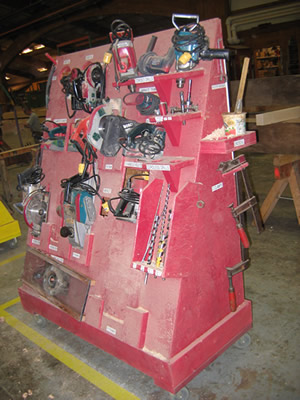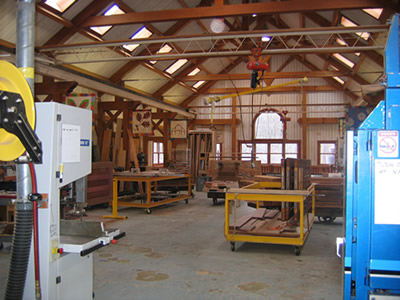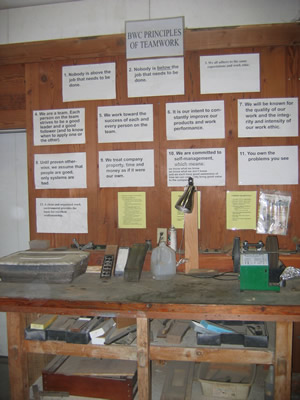Manufacturing Success Stories
The Beam Team Gets Lean
Benson Woodworking Co., Inc., Bensonwood, NH
"I am very productive by nature, very driven. I found that learning about Lean was extremely refreshing- like a woodworker getting a new tool. We now have Lean tools to address our inefficiencies. I have seen small changes make a huge difference and am embracing being the Lean Champion at Bensonwood and continuing to push the process further." –Kevin Bittenbender, Woodworking Steward and Lean Champion at Bensonwood.
At Bensonwood, employees are constantly striving to be better at what they do and everyone has a part in the process. This corporate culture made them receptive to tools that help them do things better, cheaper, and faster. So when eight Bensonwood employees had the opportunity to attend a public Time Wise Le102 (Lean training program), it is not surprising that it piqued their interest in bringing more Lean ideas into the company.
Following the public training, a Lean assessment was conducted at Bensonwood by Linda Ellis, a project manager from New Hampshire MEP, and Joe Rizzo a colleague from the Massachusetts MEP. Using the information from the assessment report and some Workforce Training funding from the state of New Hampshire, Bensonwoon began the Time Wise Lean training program.
Eighty percent of the company’s employees have now participated in the Time Wise Lean 102 training, a hands-on, job shop simulation to introduce basic lean concepts to the students and illustrate how they are used. Kevin Bittenbender, Steward of Bensonwood’s Woodworking Shop, said that the Le102 training went over very well. The comments from participants were positive – even from those who were skeptical at first.
 Overcoming Inefficient Layout and Lack of Organization Overcoming Inefficient Layout and Lack of Organization
On site work began with several Lean 5s events being conducted in the Timber Frame Shop. This shop is where they create the huge timbers which provide the major support and decoration to the timber structures made at the company. There needed to be a plan for how work would flow in the area since excessive movement of such large items was especially wasteful. There was also a lot of clutter in this shop, tools, extra material, work in process, personal, and food items. The Timber Frame Shop crew was wasting valuable time due to inefficient layout and lack of organization. Their location in the main office building also meant that the shop was often toured by customers and potential clients. The department break area, which often looked messy, was right in middle of the tour path. The shop was not giving the right impression of the fine quality work that is done by Bensonwood. But, that has now changed.
Removing material from the workspace has resulted in at least a 5% increase in active workspace since the items now take up half the space they used to. The department has assumed a 30 second rule. Everything is located so that it can be obtained in 30 seconds. This rule, along with all the 5S clean up work, has enabled the framers to cut time spent searching for tools by approximately 33%. Labeling, sorting, color coding, and new storage areas and ideas have all helped make this concept a reality.
As you enter the department there is a 5s table directly in front of you. On it, is an explanation of the 5s process – sort, set in order, shine, standardize, and sustain. (Bensonwood includes a sixth S for Safety) The team uses a checklist to make sure things around the area are in good shape each day and there is a place for employee suggestions. The Timber Frame Team created a designated break area with partial walls to offer privacy and help conceal personal and food related items from view. The 19 people in the Timber Shop have divided into teams. Every team has a captain and the duty of captain rotates to keep things fair. Each team is assigned a specific area of the shop which they are in charge of for a week, both cleaning and providing input for improvements. Every Monday all the teams get together as a group to discuss their goals and achievements. Additionally, departments share with other departments and give regular updates on what is going on. Accumulating clutter on counters was eliminated by installing slanted surfaces. Each team member has a cabinet for personal items which keeps the area free of unnecessary material.
A Disciplined Approach
A red tag area has been designated for items to be disposed of or which do not have a home or purpose. Paperwork has been color coded. For instance, a yellow note on a clipboard hanging on the wall can be seen from across the facility and signals that there is a priority to be addressed. Machinery has been cleaned and painted, and the tooling that goes with each machine is within easy reach. Storage bins and cabinets were built for related materials used for changeover or upkeep and within those are Kan Ban indicators to signify when items need replenishing or reordering. Lines on the floor identify travel and work areas. Everything is kept clean. The team has adopted discipline and as a result productivity and pass through in the Timber Department has increased. By an exit door there is a sign that says "Always Tour Ready," a reminder of how the shop should look at all times. And now it does.
 Delivering Results Delivering Results
The Timber Frame Shop is now a showplace for what can be achieved if everyone works together and believes that they are doing the right thing. Team members from other areas of Bensonwood participated in the work done in Timber Frame and were then able to share knowledge with their departments.
Other shops have taken their queue from the Timber Shop’s success and have been working on 5s clean up, mapping their processes to see where changes are needed, and thinking Lean. Woodworking, for instance, is where Bensonwood’s smaller scale and finish woodworking is done.
Producing one of Bensonwood’s custom doors used to take 20-22 man-hours. Now a door can be completed in 12 hours. This not only gets the job done in about half the time, but frees up team members to focus on more creative custom pieces and challenges which they all enjoy. Dedicated jigs used for the window trim making process have reduced set up time by approximately 90% for several machining processes. This decrease in set up time was coupled with an increase in accuracy and quality due to the jigs use as well.
Applying Lean to Custom Products
The shop remained in the original Alstead location when the rest of Bensonwood moved to Walpole. And they inherited 20 years of "stuff" which they have used 5s and other Lean tools to deal with. About 70% of what they build is repeatable, like doors and stairs, and 30% are custom, one-of-a-kind pieces. It is easy to apply Lean concepts to processes that are done over and over again, but creative thinking has taught them that there are ways to utilize repetitive processes on custom items to shorten production time as well. By being better organized they can produce everything more efficiently. In Woodworking, several jigs were created and are being used in the door building process, when cutting boards and installing hinges, during the stair making process, and even on the tool carts them selves.
The team from Woodworking used their lean tools to create a small cell for the ceiling panel process. The area is set up with just what is needed to streamline the process. Materials and tools are within reach. A guide was created to ensure correct panel size and shape every time. Now this operation is easily and efficiently accomplished by a single employee. Creating the cell has reduced the labor portion of the process by over 60%.
 Lean Champions Lean Champions
Kevin Bittenbender has become the Lean Champion at Bensonwood and stays involved with each area as they work on their Lean initiatives. He is a motivator and driving force behind continuous improvement. Kevin believes that one key to Bensonwood’s success with Lean is that they set goals. They have one year goals and some short term goals. They meet regularly as a team and evaluate each other and set standards for evaluation. It is a continuous process.
At Bensonwood, the Timber Department, the Woodworking Department, the Design Department, the Roof System Department, the Building Systems Department, and the Business Office have all embraced some Lean ideas and are seeing rewards for their efforts. Some are just beginning the process but have the success and experience of other teams to guide them. Lean stewards are regularly challenging their co-workers to come up with new ideas and improvements. In some areas, you can see where an inspired individual has helped take his team to the next level. Making things easily moveable, creating jigs, reusing materials, relaying out work stations, cleaning and labeling…some small changes with little or no cost involved can have big impacts. As Bensonwood continues to incorporate more lean ideas in their shops, they will enjoy the rewards of these improvements in their own environment as well as in those they create for others.
About Bensonwood
From early on, Tedd Benson always admired architecture. He was also determined to bring back the art of timber frame construction. So in the early 1970’s, after years of study, observation, and hands-on trial and error, he and a small group of local woodworkers started Benson Woodworking in the barn at his home in Alstead, New Hampshire. In 32 years, Bensonwood, as they are now known, has grown and evolved into a company of over 70 team members, operating out of five buildings in two towns. "The Beam Team," is comprised of engineers, architects, designers, master timber framers and craftspeople, support staff, interns, and project managers. Often, the team may include visiting woodworkers and craftspeople from around the world, who have come to learn and share ideas and skills. For more information, see http://www.bensonwood.com
|
